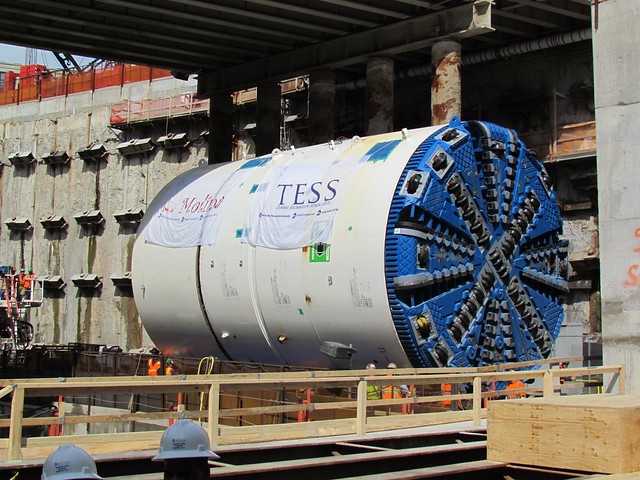
The TLC's Group Ride Vehicle Program didn't have to fail. (Photo via flickr user AllWaysNY)
Across the street from the my apartment is a former bus stop. The B71 used to run down Union St., but nearly nine months ago, it was the victim of the MTA’s budget cuts. At some point, a Group Ride Program stop sign popped up at the shelter, but the Taxi & Limousine Commission’s attempt at privatizing transit died an inglorious death. I never once laid eyes on a van making the Union St. run.
These past weekend, the dollar vans made the news again. In a brief item in The Post, two writers explore how commuter vans are picking up passengers. While the story seems to get one fact slightly wrong — the B doesn’t run on the weekends — its point remains the same. With the Q out of service from Coney Island to Midtown, commuter vans have picked up the slack.
Particularly at Aves. H and M, which are undergoing renovation and see no Manhattan-bound service, customers are grateful for the vans. “I don’t know what I would do without the dollar van. Sometimes they drive too fast, but the MTA bus goes too slow and stops too much,” one rider said.
So how did the T&LC get its program so wrong while private operators seemingly make it work? And can a quasi-organized dollar van program be successful in the city? Those are questions that still need answering.
A few months ago, I tried to gain some insight into the commuter van phenomenon. Cap’n Transit and I ventured to the Port Authority and hopped the vans across the river. For a few bucks, these vehicles run as local buses via the Lincoln Tunnel to Union City, West New York and points north. We rode up Bergenline Ave. and came back on JFK Boulevard. The rides are a bit sluggish, but it worked.
In particular, it worked because it adds service to areas that need it. These avenues that run parallel to Manhattan in the eastern urban areas in New Jersey are major commercial destinations, and driving is either too expensive or too much of a pain. New Jersey Transit buses serve the area, but the commuter vans provide lower-cost and more frequent options. They leave New York when they’re full and run often back into the city.
Most vital to the success of these vans though is the nature of the routes. They run what are termed feeder routes. They duplicate bus services in areas that need it and provide other connections that do not enjoy adequate mass transit access. Unlike the T&LC’s pilot program, demand is key. The B71 was eliminated because its ridership was so low. Private service introduced months later won’t solve that basic problem, but commuter vans between Chinatowns in New York City work perfectly well.
Of course, not everything is rosy for these vans. As an article in December noted, 60 percent of the commuter vans failed surprise safety inspections. The program there is loosely regulated, but riders get what they pay for.
In the city, then, the problem was one of focus. Private transit cannot replace mass transit lines eliminated due to high operating costs and low service. Rather, private transit can fill in the gaps. If the Taxi and Limousine Commission can figure out how to license a program that fills in the gaps — or if it can figure out what the gaps are first — the commuter vans can play a role in New York. Otherwise, they’ll simply show that perhaps the MTA had good reason to cut a bunch of bus routes.

 Two weeks ago, subway riders in Queens had the pleasure of experience the pitfalls of aging infrastructure. Heavy rainfalls and what the MTA termed a “preexisting water condition” damaged 800 feet of track in the Manhattan-bound Steinway Tube, and thus the 7 train could not operate into the city.
Two weeks ago, subway riders in Queens had the pleasure of experience the pitfalls of aging infrastructure. Heavy rainfalls and what the MTA termed a “preexisting water condition” damaged 800 feet of track in the Manhattan-bound Steinway Tube, and thus the 7 train could not operate into the city.





 (Rockaway Shuttle)
(Rockaway Shuttle)






